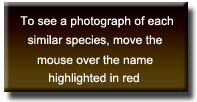
 |
|
Leucania pseudargyria is the usually the easiest of the four species to recognize because of its larger size and the red tint to the forewings usually (but not always) present.
Males of Leucania inermis are easily recognized by the absence of a tuft of long hairs on the prothoracic tibia. This tuft of hairs is present in the other three species. Leucania inermis tends to be slightly larger on the average than ursula and both species are always gray without the red tints present in the larger pseudargyia. The discal dot in the reniform of calidior is strong, but too few species of this species are known to make sweeping statements about its superficial appearance. Females of inermis and ursula are usually best identified by their association with males.
Males of Leucania inermis are easily recognized by the absence of a tuft of long hairs on the prothoracic tibia. This tuft of hairs is present in the other three species. Leucania inermis tends to be slightly larger on the average than ursula and both species are always gray without the red tints present in the larger pseudargyia. The discal dot in the reniform of calidior is strong, but too few species of this species are known to make sweeping statements about its superficial appearance. Females of inermis and ursula are usually best identified by their association with males. Leucania calidior (Forbes)
Diagnosis: A species of the southeastern United States. Forewing gray-brown, about 35 mm. in expanse from wingtip to wingtip. Orbicular and reniform both represented by pale spots in the wing, the reniform with a prominent, black spot. Antemedial and postmedial lines present, but vague. Apex of forewing with a light triangle at the apex accented below with a dark gray triangle. Hindwing heavily suffused with dark gray-brown. Prothoracic tibia with a prominent tuft of hairs. Distribution: This species is represented in the National Museum of Natural History by only two specimens; one from Atlanta and the other from Athens, both in Georgia. The species probably has a wider distribution in the southeastern United States. Identification Quality: Excellent |
Leucania calidior
Similar Species: Leucania pseudargyria Leucania ursula Leucania inermis
|
Similar Species
|
 |
